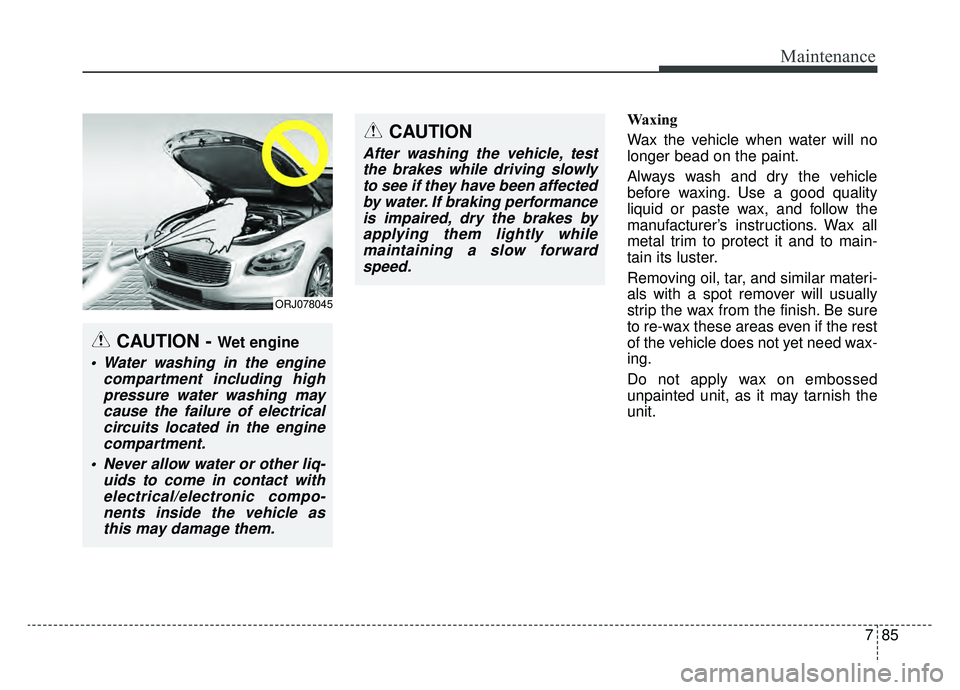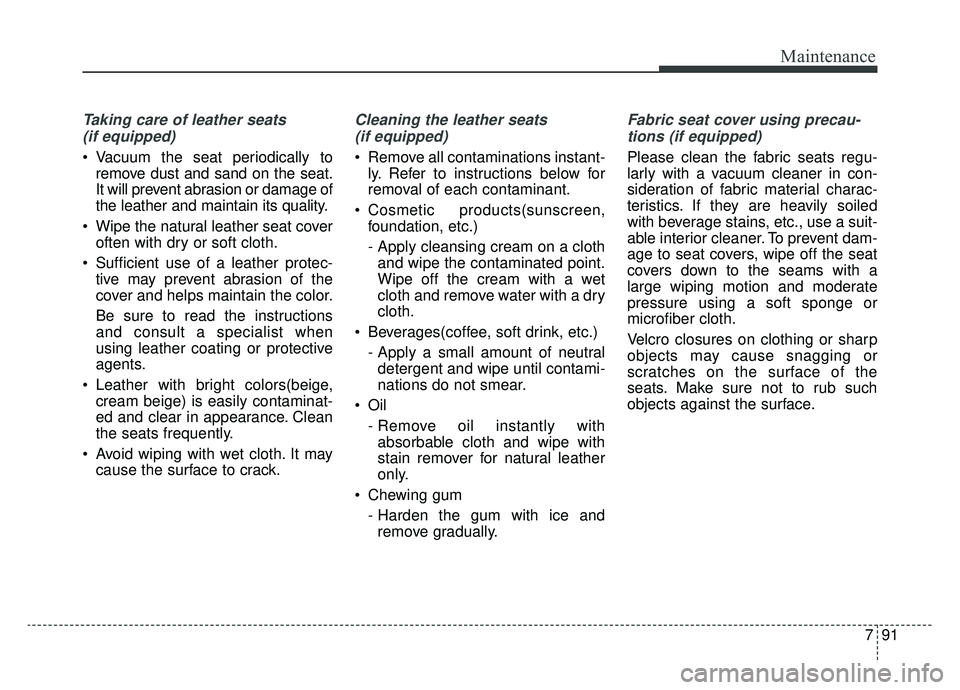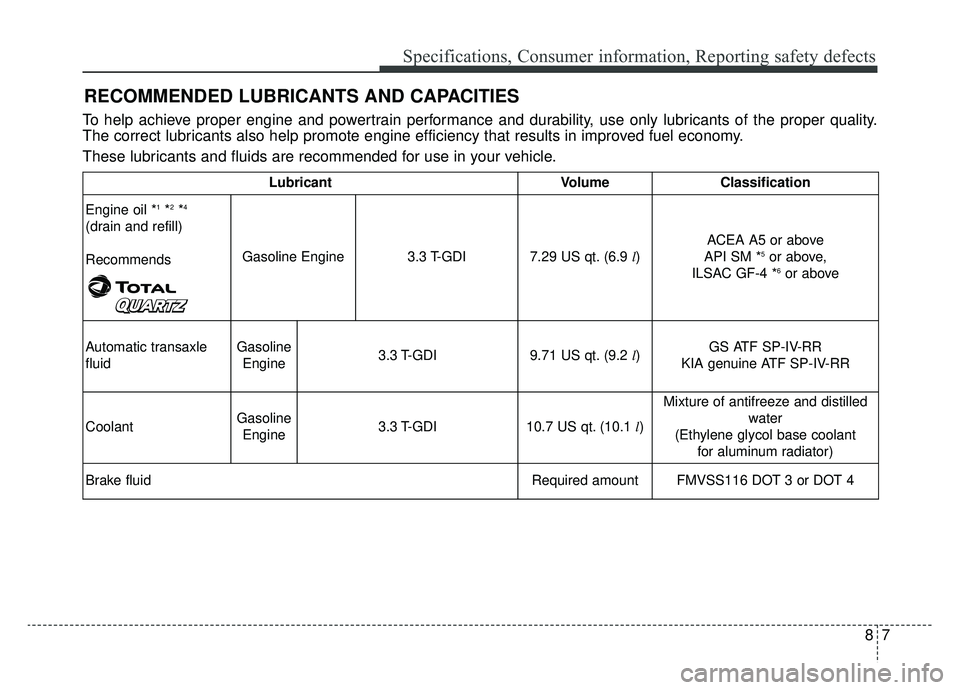2019 KIA K900 oil
[x] Cancel search: oilPage 539 of 580

785
Maintenance
Waxing
Wax the vehicle when water will no
longer bead on the paint.
Always wash and dry the vehicle
before waxing. Use a good quality
liquid or paste wax, and follow the
manufacturer’s instructions. Wax all
metal trim to protect it and to main-
tain its luster.
Removing oil, tar, and similar materi-
als with a spot remover will usually
strip the wax from the finish. Be sure
to re-wax these areas even if the rest
of the vehicle does not yet need wax-
ing.
Do not apply wax on embossed
unpainted unit, as it may tarnish the
unit.
ORJ078045
CAUTION - Wet engine
Water washing in the enginecompartment including highpressure water washing maycause the failure of electricalcircuits located in the enginecompartment.
Never allow water or other liq- uids to come in contact withelectrical/electronic compo-nents inside the vehicle asthis may damage them.
CAUTION
After washing the vehicle, testthe brakes while driving slowlyto see if they have been affectedby water. If braking performanceis impaired, dry the brakes byapplying them lightly whilemaintaining a slow forwardspeed.
Page 543 of 580

789
Maintenance
When cleaning lower door panels,rocker panels and frame members,
be sure that drain holes are kept
open so that moisture can escape
and not be trapped inside to accel-
erate corrosion.
Keep your garage dry
Don't park your vehicle in a damp,
poorly ventilated garage. This cre-
ates a favorable environment for cor-
rosion. This is particularly true if you
wash your vehicle in the garage or
drive it into the garage when it is still
wet or covered with snow, ice or
mud. Even a heated garage can con-
tribute to corrosion unless it is well
ventilated so moisture is dispersed. Keep paint and trim in good con-
dition
Scratches or chips in the finish
should be covered with "touch-up"
paint as soon as possible to reduce
the possibility of corrosion. If bare
metal is showing through, the atten-
tion of a qualified body and paint
shop is recommended.
Bird droppings : Bird droppings are
highly corrosive and may damage
painted surfaces in just a few hours.
Always remove bird droppings as
soon as possible.
Don't neglect the interior
Moisture can collect under the floor
mats and carpeting and cause corro-
sion. Check under the mats periodi-
cally to be sure the carpeting is dry.
Use particular care if you carry fertil-
izers, cleaning materials or chemi-
cals in the vehicle.
These should be carried only in prop-
er containers and any spills or leaks
should be cleaned up, flushed with
clean water and thoroughly dried.Interior care
Interior general precautions
Prevent chemicals such as perfume,
cosmetic oil, sun cream, hand clean-
er, and air freshener from contacting
the interior parts because they may
cause damage or discoloration. If
they do contact the interior parts,
wipe them off immediately. If neces-
sary, use a vinyl cleaner, see product
instructions for correct usage.
Page 544 of 580

Maintenance
90
7
Cleaning the upholstery and inte-
rior trim
Vinyl
Remove dust and loose dirt from
vinyl with a whisk broom or vacuum
cleaner. Clean vinyl surfaces with a
vinyl cleaner.
Fabric
Remove dust and loose dirt from fab-
ric with a whisk broom or vacuum
cleaner. Clean with a mild soap solu-
tion recommended for upholstery or
carpets. Remove fresh spots imme-
diately with a fabric spot cleaner. If
fresh spots do not receive immediate
attention, the fabric can be stained
and its color can be affected. Also, its
fire-resistant properties can be
reduced if the material is not proper-
ly maintained.
Using anything but recommended
cleaners and procedures may affect
the fabric’s appearance and fire-
resistant properties.
Cleaning the lap/shoulder beltwebbing
Clean the belt webbing with any mild
soap solution recommended for
cleaning upholstery or carpet. Follow
the instructions provided with the
soap. Do not bleach or re-dye the
webbing because this may weaken it.
Cleaning the interior windowglass
If the interior glass surfaces of the
vehicle become fogged (that is, cov-
ered with an oily, greasy or waxy
film), they should be cleaned with a
glass cleaner. Follow the directions
on the glass cleaner container.
CAUTION- Rear window
Do not scrape or scratch theinside of the rear window. Thismay result in damage of the rearwindow defroster grid.
CAUTION - Electrical
components
Never allow water or other liq-uids to come in contact withelectrical/electronic compo-nents inside the vehicle as thismay damage them.
CAUTION - Leather
When cleaning leather products(steering wheel, seats etc.), useneutral detergents or low alco-hol content solutions. If you usehigh alcohol content solutionsor acid/alkaline detergents, thecolor of the leather may fade orthe surface may get stripped off.
Page 545 of 580

791
Maintenance
Taking care of leather seats (if equipped)
Vacuum the seat periodically to remove dust and sand on the seat.
It will prevent abrasion or damage of
the leather and maintain its quality.
Wipe the natural leather seat cover often with dry or soft cloth.
Sufficient use of a leather protec- tive may prevent abrasion of the
cover and helps maintain the color.
Be sure to read the instructions
and consult a specialist when
using leather coating or protective
agents.
Leather with bright colors(beige, cream beige) is easily contaminat-
ed and clear in appearance. Clean
the seats frequently.
Avoid wiping with wet cloth. It may cause the surface to crack.
Cleaning the leather seats
(if equipped)
Remove all contaminations instant- ly. Refer to instructions below for
removal of each contaminant.
Cosmetic products(sunscreen, foundation, etc.)
- Apply cleansing cream on a clothand wipe the contaminated point.
Wipe off the cream with a wet
cloth and remove water with a dry
cloth.
Beverages(coffee, soft drink, etc.) - Apply a small amount of neutraldetergent and wipe until contami-
nations do not smear.
Oil - Remove oil instantly withabsorbable cloth and wipe with
stain remover for natural leather
only.
Chewing gum - Harden the gum with ice andremove gradually.
Fabric seat cover using precau-
tions (if equipped)
Please clean the fabric seats regu-
larly with a vacuum cleaner in con-
sideration of fabric material charac-
teristics. If they are heavily soiled
with beverage stains, etc., use a suit-
able interior cleaner. To prevent dam-
age to seat covers, wipe off the seat
covers down to the seams with a
large wiping motion and moderate
pressure using a soft sponge or
microfiber cloth.
Velcro closures on clothing or sharp
objects may cause snagging or
scratches on the surface of the
seats. Make sure not to rub such
objects against the surface.
Page 556 of 580

87
Specifications, Consumer information, Reporting safety defects
RECOMMENDED LUBRICANTS AND CAPACITIES
To help achieve proper engine and powertrain performance and durability, use only lubricants of the proper quality.
The correct lubricants also help promote engine efficiency that results in improved fuel economy.
These lubricants and fluids are recommended for use in your vehicle.
Lubricant VolumeClassification
Engine oil *1*2*4
(drain and refill)
Recommends
Gasoline Engine 3.3 T-GDI7.29 US qt. (6.9 l)
ACEA A5 or above
API SM *5or above,
ILSAC GF-4 *6or above
Automatic transaxle
fluidGasoline Engine 3.3 T-GDI9.71 US qt. (9.2 l)GS ATF SP-IV-RR
KIA genuine ATF SP-IV-RR
CoolantGasoline Engine3.3 T-GDI10.7 US qt. (10.1 l)
Mixture of antifreeze and distilled
water
(Ethylene glycol base coolant for aluminum radiator)
Brake fluidRequired amountFMVSS116 DOT 3 or DOT 4
Page 557 of 580

Specifications, Consumer information, Reporting safety defects
88
Lubricant VolumeClassification
Rear differential oil1.48 US qt. (1.4 l)HYPOID GEAR OIL API GL-5 SAE 75W85
(SK HK SYN GEAR OIL 75W85)
Front differential oil *3
(AWD)0.74 US qt. (0.7 l)HYPOID GEAR OIL API GL-5 SAE 75W/85
(SK HK SYN GEAR OIL 75W85)
Transfer oil
(AWD)Gear/ Clutch0.60 US qt. (0.57 l)
SHELL TF 0870B
Actuator0.26 US qt. (0.25 l)
FuelGasoline Engine81.4 US qt. (77 l)Refer to Fuel requirements in chapter 1
*1: Refer to the recommended SAE viscosity numbers on the next page.
*2: Engine oils labeled Energy Conserving Oil are now available. Along with other additional benefits, they contribute to fuel economy by reducing the amount of fuel necessary to overcome engine friction. Often, these improvements are difficult to measure in everyday driving, but in a year’s
time, they can offer significant cost and energy savings.
*
3: Regardless of oil change intervals, replace oil immediately if Rear-Differential or Front-Differential is submerged.
*4: If the ACEA A5 oil is not available in your country , you are able to use API service SM/ILSAC GF-4 engine oil.
*5: If the API SM engine oil is not available, you can use API SN or above.
*6: If the ILSAC GF-4 engine oil is not available, you can use ILSAC GF-5 or above.
Page 558 of 580

89
Specifications, Consumer information, Reporting safety defects
Recommended SAE viscosity
number
Engine oil viscosity (thickness) has an
effect on fuel economy and cold
weather operating (engine start and
engine oil flowability). Lower viscosity
engine oils can provide better fuel
economy and cold weather perform-
ance; however, higher viscosity
engine oils are required for satisfacto-
ry lubrication in hot weather. Using
oils of any viscosity other than those
recommended could result in engine
damage. When choosing an oil, con-
sider the range of temperature your
vehicle will be operated in before the
next oil change. Proceed to select the
recommended oil viscosity from the
chart.
An engine oil displaying this API Certification Mark con-
forms to the international Lubricant Specification Advisory
Committee (ILSAC). It is recommended to only use engine
oils that uphold this API Certification Mark.
Temperature Range for SAE Viscosity Numbers
Temperature°C
(°F)-30 -20 -10 0 10 20 30 40 50 -10 0 20 40 60 80 100 120
Gasoline Engine Oil10W-30
5W-30 *1
*1: For better fuel economy, It is recommended to use the engine oil of a viscosity grade SAE
5W30. However, if the engine oil is not available in your country, select the proper engine oil
using the engine oil viscosity chart.
Page 568 of 580

I3
Index
Battery replacement. . . . . . . . . . . . . . . . . . . . . . . 4-10, 7-34
Battery saver function . . . . . . . . . . . . . . . . . . . . . . . . . 4-114
Battery. . . . . . . . . . . . . . . . . . . . . . . . . . . . . . . . . . . . \
. . 7-34Battery replacement . . . . . . . . . . . . . . . . . . . . . . . . . 7-34
Recharging the battery . . . . . . . . . . . . . . . . . . . . . . . 7-36
Reset items . . . . . . . . . . . . . . . . . . . . . . . . . . . . . . . . 7-37
Before driving . . . . . . . . . . . . . . . . . . . . . . . . . . . . . . . . . 5-5
Blade inspection . . . . . . . . . . . . . . . . . . . . . . . . . . . . . . 7-31
Blade replacement . . . . . . . . . . . . . . . . . . . . . . . . . . . . 7-31
Blind-Spot Collision Warning/ Blind-Spot Collision-Avoidance Assist system . . . . . . . . . . . . 5-116
System description . . . . . . . . . . . . . . . . . . . . . . . . . 5-116
System setting and activation . . . . . . . . . . . . . . . . . 5-117
Warning message and system control . . . . . . . . . . 5-119
Limitations of the system . . . . . . . . . . . . . . . . . . . . 5-125
Blind-spot view monitor system . . . . . . . . . . . . . . . . . 4-113
Bonnet see the hood . . . . . . . . . . . . . . . . . . . . . . . . . . . 4-42
Brake discs, pads, calipers and rotors. . . . . . . . . . . . . . 7-20
Brake fluid . . . . . . . . . . . . . . . . . . . . . . . . . . . . . . 7-19, 7-26 Checking the brake fluid level . . . . . . . . . . . . . . . . . 7-26
Brake hoses and lines . . . . . . . . . . . . . . . . . . . . . . . . . . 7-19
Brake system. . . . . . . . . . . . . . . . . . . . . . . . . . . . . . . . . 5-31 Power brakes . . . . . . . . . . . . . . . . . . . . . . . . . . . . . . 5-31
Electronic Parking Brake (EPB) . . . . . . . . . . . . . . . 5-33
Auto hold . . . . . . . . . . . . . . . . . . . . . . . . . . . . . . . . . 5-39
Anti-lock Brake System (ABS) . . . . . . . . . . . . . . . . 5-43 Electronic Stability Control (ESC) . . . . . . . . . . . . . 5-45
Vehicle Stability Management (VSM) . . . . . . . . . . . 5-49
Hill-start Assist Control (HAC) . . . . . . . . . . . . . . . . 5-51
Button start/stop, see engine start/stop button . . . . . . . . 5-7
California perchlorate notice . . . . . . . . . . . . . . . . . . . . 7-95
Camera (rear view) . . . . . . . . . . . . . . . . . . . . . . . . . . . 4-111
Care Care of seat belts . . . . . . . . . . . . . . . . . . . . . . . . . . . 3-38
SRS Care . . . . . . . . . . . . . . . . . . . . . . . . . . . . . . . . . 3-75
Care of seat belts . . . . . . . . . . . . . . . . . . . . . . . . . . . . . 3-38
Center console storage . . . . . . . . . . . . . . . . . . . . . . . . 4-151
Central door lock switch. . . . . . . . . . . . . . . . . . . . . . . . 4-19
Chains - Tire . . . . . . . . . . . . . . . . . . . . . . . . . . . . . . . . 5-153
Changing the coolant . . . . . . . . . . . . . . . . . . . . . . . . . . 7-25
Changing the engine oil and filter . . . . . . . . . . . . . . . . 7-22
Checking fluid levels . . . . . . . . . . . . . . . . . . . . . . . . . . 7-20
Checking the brake fluid level . . . . . . . . . . . . . . . . . . . 7-26
Checking the coolant level . . . . . . . . . . . . . . . . . . . . . . 7-23
Checking the engine oil level . . . . . . . . . . . . . . . . . . . . 7-21
Checking the washer fluid level . . . . . . . . . . . . . . . . . . 7-27
Checking tire inflation pressure . . . . . . . . . . . . . . . . . . 7-39
C
B